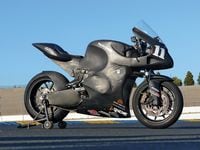When** MotoGP's intermediate class** was restructured in 2010, many motorcyclists expected a flowering of new and innovative motorcycle designs. Rules for the new class, called Moto2, mandated a spec engine—based on the Honda CBR600RR—but also required non-production-based chassis designs meant to encourage novel thinking.
Fans anticipated a torrent of innovation, but what's happened is almost the opposite. The Moto2 grid is populated by bikes that are almost indistinguishable from each other. There are, however, a few exceptions that prove the rule—and also show how difficult it is to challenge the status quo.
Four years into Moto2, only one entrant has used anything other than a conventional telescopic fork. This was the French Promoto Sport team, a wild-card entry in last summer's Czech GP with its Transfiormers project bike. That's not a typo; it's a reference to French racer/inventor Claude Fior, who built a series of radical racebikes in the 1980s and '90s using an alternative front-end design.
The Fior fork is superficially similar to the BMW Duolever (invented by Norman Hossack in the late '70s). Both designs use a rigid fork suspended by two A-arms located above the front wheel, with a conventional coil-over shock controlling their motion. The primary difference is in the steering mechanism: Hossack used a folding bar; Fior, a pivoting yoke. The Transfiormers bike, ridden by Lucas Mahias, qualified 31st of 34 entries and finished 23rd—not a bad result for a one-off wild card.
A second radical Moto2 design has been built and tested but not yet raced: TaylorMade Racing's Carbon2 (Up To Speed, May 2011 MC). Designed by Paul Taylor and John Keogh, this bike uses many innovations pioneered on their Saxon Triumph racers of the '90s but goes further with an all-carbon-fiber monocoque chassis. Like the Saxon bikes, the Carbon2 suspends the front wheel with a braced telescopic fork similar to BMW's Telelever design, with a ducted underseat radiator cooling the engine.
The Carbon2 was shown at the Goodwood Festival of Speed in June 2013; in September, a Brough Superior-branded Carbon2 announced TaylorMade's participation in the present Brough Superior revival, with allusions to the fact that the new team might enter Moto2 competition soon. Will that happen? It's too early to say for sure, but this gets us back to the primary difficulty of competing in the Moto2 class: The deck is stacked to discourage small prototype manufacturers.
Three companies currently dominate Moto2. Of the 34 total entrants at Brno, 12 used the Kalex chassis, eight used Suter, and another eight used Speed Up. That's 80 percent of the field on the same three bikes. Counting all the bikes sold to Moto2 teams, CEV (Spanish Championship) teams, teams in other national series, and a few sold for private use—not to mention spares—each of these companies has to be building 50-plus machines per year. No matter how FIM rules classify these machines, they aren't prototypes by any common definition. They are limited-production bikes.
What does it matter if Moto2 is, in fact, a limited-production series and not a prototype series as advertised? It's so far a very successful series, with full fields and good racing. There's nothing wrong with that. But it's not regulated or operated as a true prototype series, which makes things more difficult for teams wanting to develop and race true prototypes like the Transfiormers and Carbon2 machines.
It's a question of infrastructure. Teams choosing Kalex, Suter, or Speed Up are racing the cumulative result of millions of dollars and thousands of hours of design, research, testing, and development. For the prototype teams, it's hardly a level playing field. For those of us who want racing competition to drive motorcycle technology into new and more innovative directions, Moto2 falls short of that promise, too.











/cloudfront-us-east-1.images.arcpublishing.com/octane/QCZEPHQAMRHZPLHTDJBIJVWL3M.jpg)
/cloudfront-us-east-1.images.arcpublishing.com/octane/HXOUJXQWA5HBHGRO3EMJIGFMVI.jpg)

/cloudfront-us-east-1.images.arcpublishing.com/octane/3TIWWRV4JBBOLDVGRYECVVTA7Y.jpg)
/cloudfront-us-east-1.images.arcpublishing.com/octane/KIX5O23D5NAIBGFXBN3327DKZU.jpg)
/cloudfront-us-east-1.images.arcpublishing.com/octane/7GJYDUIPXRGMTMQKN6ONYOLBOU.jpg)
/cloudfront-us-east-1.images.arcpublishing.com/octane/MUQLOVLL2ZDGFH25ILABNBXKTI.jpg)
/cloudfront-us-east-1.images.arcpublishing.com/octane/TNOU5DNE2BC57MFPMGN2EIDXAM.jpg)
/cloudfront-us-east-1.images.arcpublishing.com/octane/GTCXACQGJ5HAPDTGWUQKDEH44E.jpg)
/cloudfront-us-east-1.images.arcpublishing.com/octane/S35YGSEMEZB4BLTDJTSZPF4GLA.jpg)
/cloudfront-us-east-1.images.arcpublishing.com/octane/5UOT6HPX2JFMRJAX6EH45AR4MQ.jpg)
/cloudfront-us-east-1.images.arcpublishing.com/octane/OKWOJWAKP5EP3OACCRRWPCIX2Q.jpg)
/cloudfront-us-east-1.images.arcpublishing.com/octane/2WF3SCE3NFBQXLDNJM7KMXA45E.jpg)
/cloudfront-us-east-1.images.arcpublishing.com/octane/G4MG6OUCJNBSHIS2MVVOTPX65E.jpg)
/cloudfront-us-east-1.images.arcpublishing.com/octane/IIGGWFOTOJGB7DB6DGBXCCMTDY.jpg)
/cloudfront-us-east-1.images.arcpublishing.com/octane/QSTCM6AVEZA5JJBUXNIQ3DSOF4.jpg)
/cloudfront-us-east-1.images.arcpublishing.com/octane/U4I7G625B5DMLF2DVIJDFZVV6M.jpg)
/cloudfront-us-east-1.images.arcpublishing.com/octane/B6XD6LS6IVCQPIU6HXDJSM3FHY.jpg)
/cloudfront-us-east-1.images.arcpublishing.com/octane/ICL63FEDDRDTTMINYICCEYGMDA.jpg)
/cloudfront-us-east-1.images.arcpublishing.com/octane/FCGZHQXRBZFLBAPC5SDIQLVF4I.jpg)
/cloudfront-us-east-1.images.arcpublishing.com/octane/WNOB6LDOIFFHJKPSVIWDYUGOPM.jpg)

/cloudfront-us-east-1.images.arcpublishing.com/octane/X33NU3E525ECRHXLNUJN2FTRKI.jpg)
/cloudfront-us-east-1.images.arcpublishing.com/octane/6KKT5NNL2JAVBOXMZYS5ZO76YA.jpg)